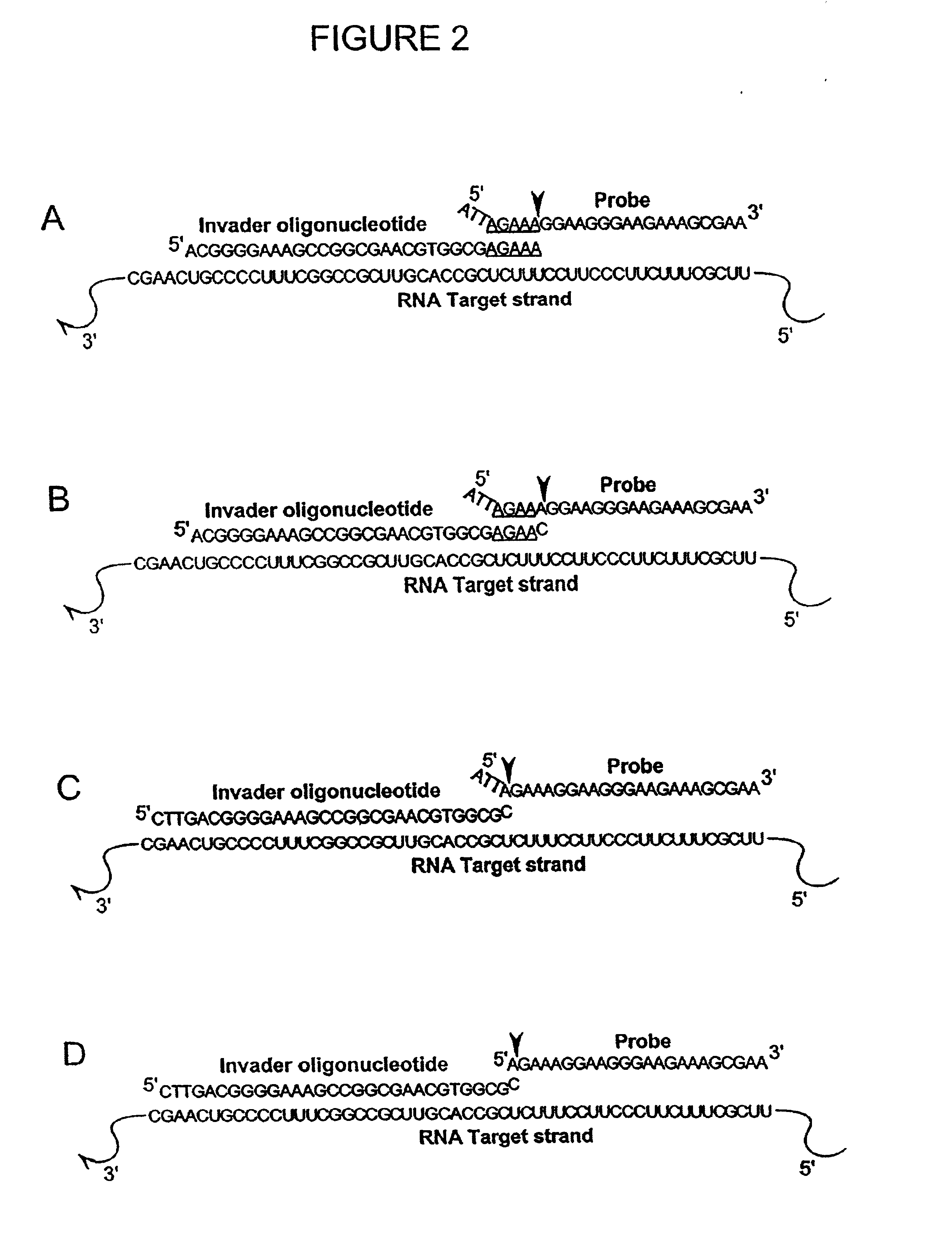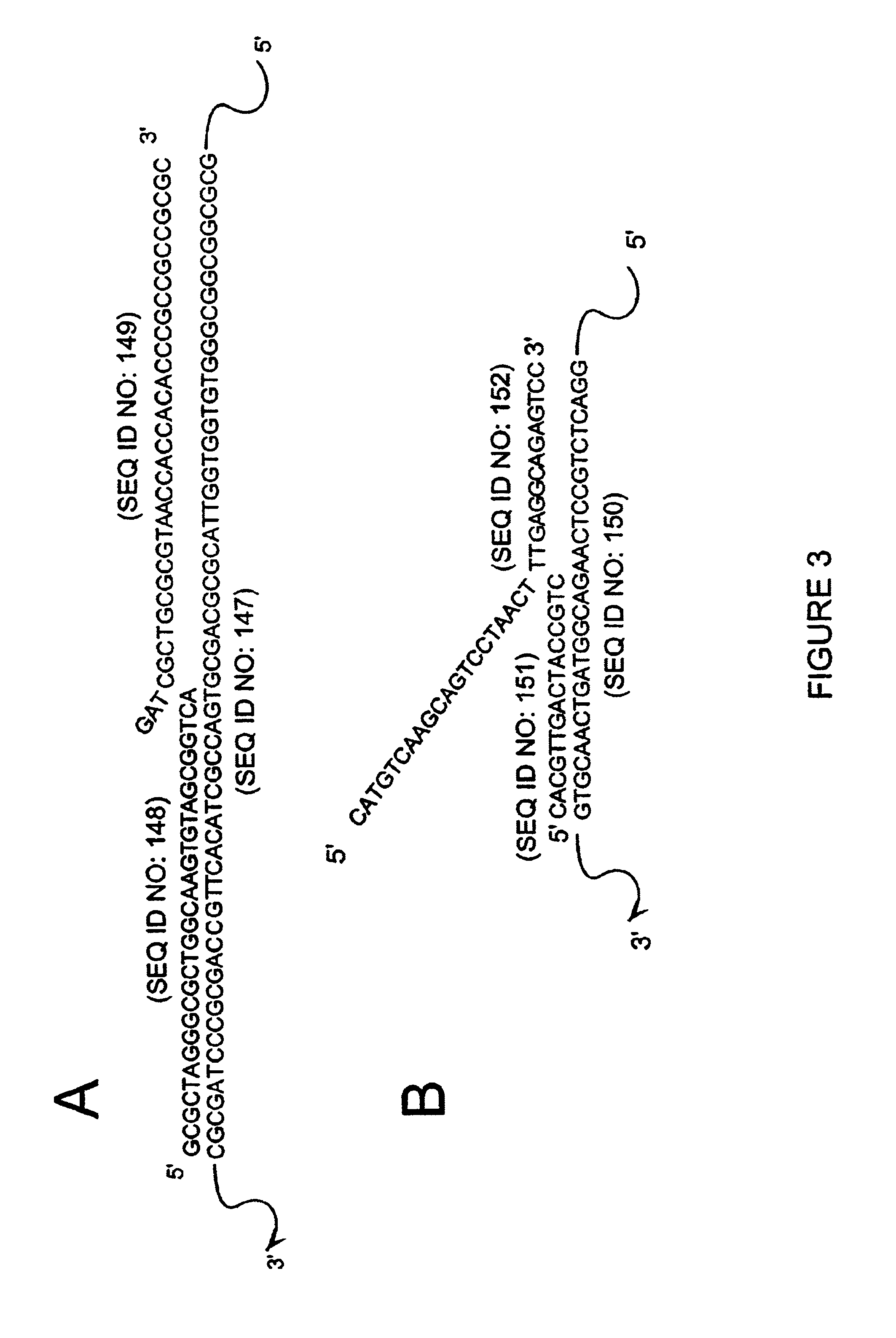Detection of RNA Sequences
a nucleic acid sequence and detection method technology, applied in the field of detection and characterization of nucleic acid sequences, can solve the problems of ineffective thermostable dna ligases, limited use of lcr for mutant screening, and inability to raise reaction temperatures to prevent, etc., to achieve improved detection assay performance, altered structure, and improved detection
- Summary
- Abstract
- Description
- Claims
- Application Information
AI Technical Summary
Benefits of technology
Problems solved by technology
Method used
Image
Examples
example 1
Rapid Screening of Colonies for 5′ Nuclease Activity
[0649]The native 5′ nucleases and the enzymes of the present invention can be tested directly for a variety of functions. These include, but are not limited to, 5′ nuclease activity on RNA or DNA targets and background specificity using alternative substrates representing structures that may be present in a target detection reaction. Examples of nucleic acid molecules having suitable test structures are shown schematically in FIGS. 18A-D and FIGS. 21-24. The screening techniques described below were developed to quickly and efficiently characterize 5′ nucleases and to determine whether the new 5′ nucleases have any improved or desired activities. Enzymes that show improved cycling rates on RNA or DNA targets, or that result in reduced target-independent cleavage merit more thorough investigation. In general, the modified proteins developed by random mutagenesis were tested by rapid colony screen on the substrates shown in FIGS. 18A...
example 2
Cloning and Expression of 5′ Nucleases of DNA Polymerases and Mutant Polymerases
A. DNA Polymerases of Thermus aquaticus and Thermus thermophilus
[0670]1. Cloning of TaqPol and TthPol
[0671]Type A DNA polymerases from eubacteria of the genus Thermus share extensive protein sequence identity (90% in the polymerization domain, using the Lipman-Pearson method in the DNA analysis software from DNAStar, WI) and behave similarly in both polymerization and nuclease assays. Therefore, the genes for the DNA polymerase of Thermus aquaticus (TaqPol), Thermus thermophilus (TthPol) and Thermus scotoductus were used as representatives of this class. Polymerase genes from other eubacterial organisms, including, but not limited to, Escherichia coli, Streptococcus pneumoniae, Mycobacterium smegmatis, Thermus thermophilus, Thermus sp., Thermotoga maritima, Thermosipho africanus, and Bacillus stearothermophilus are equally suitable.
a. Initial TaqPol Isolation: Mutant TaqA / G
[0672]The Taq DNA polymerase g...
example 3
RNA-dependent 5′ Nuclease Activity of TthPol can be Conferred on TaqPol by Transfer of the N-terminal Portion of the DNA Polymerase Domain
A. Preparation and Purification of Substrate Structures Having either a DNA or an RNA Target Strand
[0704]The downstream (SEQ ID NO:162) and upstream probes (SEQ ID NO:161) and the IL-6 DNA (SEQ ID NO:163) (FIG. 10) target strand were synthesized on a PerSeptive Biosystems instrument using standard phosphoramidite chemistry (Glen Research). The synthetic RNA-DNA chimeric IrT target labeled with biotin at the 5′-end (FIG. 20A) was synthesized utilizing 2′-ACE RNA chemistry (Dharmacon Research). The 2′-protecting groups were removed by acid-catalyzed hydrolysis according to the manufacturer's instructions. The downstream probes labeled with 5′-fluorescein (Fl) or 5′-tetrachloro-fluorescein (TET) at their 5′ ends were purified by reverse phase HPLC using a Resource Q column (Amersham-Pharmacia Biotech). The 648-nucleotide IL-6 RNA target (SEQ ID NO:16...
PUM
| Property | Measurement | Unit |
|---|---|---|
| Temperature | aaaaa | aaaaa |
| Molar density | aaaaa | aaaaa |
| Molar density | aaaaa | aaaaa |
Abstract
Description
Claims
Application Information
 Login to View More
Login to View More - R&D
- Intellectual Property
- Life Sciences
- Materials
- Tech Scout
- Unparalleled Data Quality
- Higher Quality Content
- 60% Fewer Hallucinations
Browse by: Latest US Patents, China's latest patents, Technical Efficacy Thesaurus, Application Domain, Technology Topic, Popular Technical Reports.
© 2025 PatSnap. All rights reserved.Legal|Privacy policy|Modern Slavery Act Transparency Statement|Sitemap|About US| Contact US: help@patsnap.com



